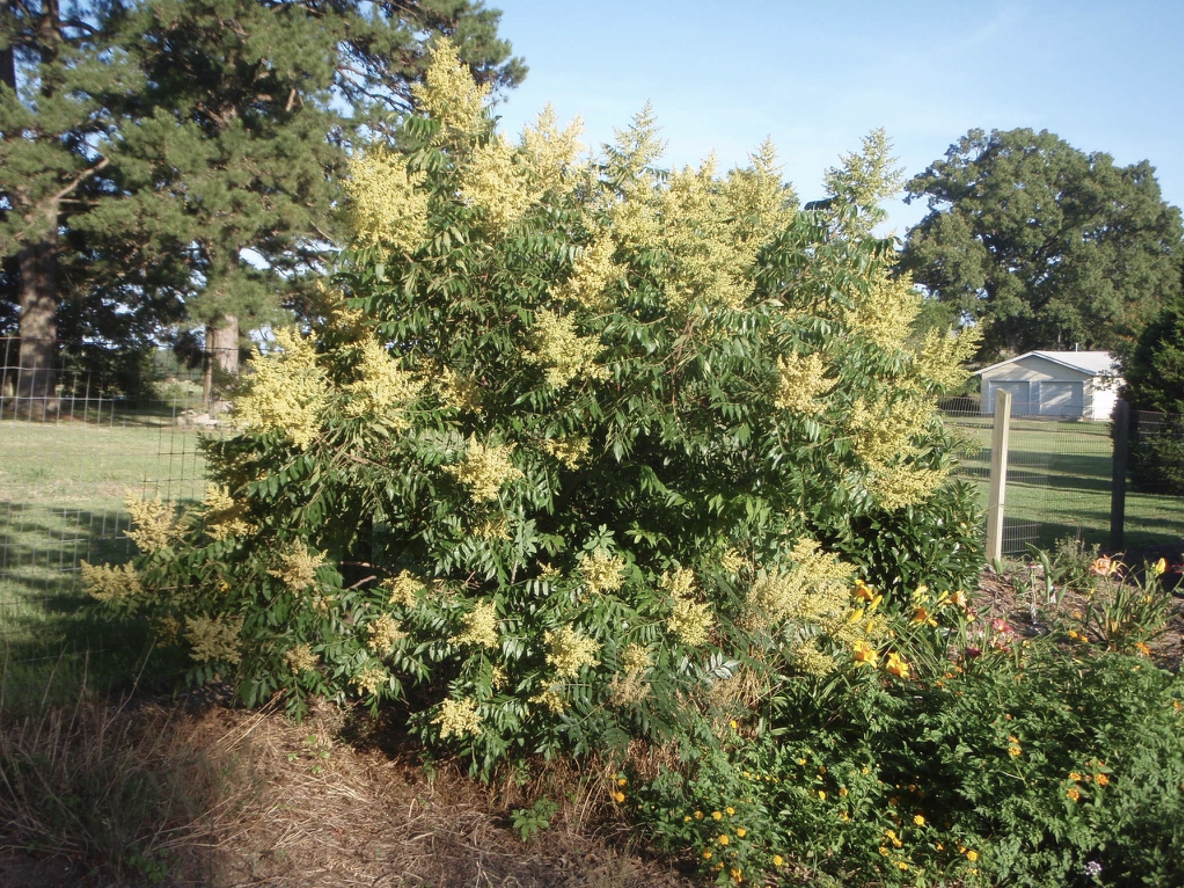Rhus copallinum: Shining sumac

Latin name: Rhus copallinum13
Common name: Shining sumac13
Flowers: Large greenish-yellow showy panicles, bloom July-September13
Fruit: Red-black drupe, showy clusters in Fall/Winter13
Height & Width: 7-15 ft x 10-20 ft13
Type: Deciduous 13
Habit: Erect, mounding, spreading 13
Wetland indicator category**: UPL in the Atlantic & Gulf Coastal Plain region and FACU in the Eastern Mountains & Piedmont Region17
Texture: Medium 13
Growth rate: Medium 13
Light: Full-sun to partial shade 13
Moisture: Medium, dry-tolerant 13
Soil*: Slightly-acidic to neutral, pH 6-8 13
Zones: 4a-9b 13
Origin: CAN and L48, including SC 16
Ecosystem benefits: Host for Luna moths, other plant parts consumed by butterflies, birds, bees, deer, small mammals 13
Features: Shining sumac is a clumping large shrub/small tree with large, attractive panicles and showy fruit. Many parts of the plant are used by insects and wildlife as food. Shining sumac is fire resistant and drought & heat resistant. It is a good choice for pollinator gardens, naturalized gardens, meadows and prairies, and native plant gardens13.
Siting: Shining sumac should be planted in open areas with full sun. The plant does not need lots of moisture and can handle dry conditions but does best in fertile soil. Should be placed where it has adequate sunlight and nutrients in places like fields, forest edges, garden beds 13.
Care: Plant so root flare is visible at soil surface14. At planting, water the root ball daily with two gallons of water per inch of trunk diameter for two weeks, every other day for two months and then weekly until established. Modify water recommendations to reflect site drainage and rainfall. Apply 3” of mulch over the planted area. Do not allow mulch to touch the trunk14.
Pests: Plants are relatively pest resistant if cultural preferences are met13.
This plant does not appear on the following invasive plant lists on 10/13/21:
USDA SC Invasive Plant Species
SC Exotic Plant Pest Council
Author: Carson Colenbaugh
Image source: https://s3.amazonaws.com/eit-planttoolbox-prod/media/images/Rhus_copallina_flfm__Cn1W80LbPfCQ.jfif
Sources:
- Armitage, A. (2001). Armitage’s manual of annuals, biennials, and half-hardy perennials. Portland, OR: Timber Press.
- Armitage, A. (2006). Armitage’s native plants for North American gardens. Portland, Oregon: Timber Press.
- Armitage, A. (2008). Herbaceous perennial plants: A treatise on their identification, culture, and garden attributes. Athens, GA: University of Geogia.
- Clemson Cooperative Extension Home and Garden Information Center.(2011). Flowers fact sheets. Retrieved from https://hgic.clemson.edu/category/flowers/
- Clemson Cooperative Extension Home and Garden Information Center.(2011). Groundcovers & vines fact sheets. Retrieved from https://hgic.clemson.edu/category/groundcovers/
- Clemson Cooperative Extension Home and Garden Information Center.(2011). Trees. Retrieved from https://hgic.clemson.edu/category/trees/
- Clemson Cooperative Extension Home and Garden Information Center.(2011). Shrubs. Retrieved from https://hgic.clemson.edu/category/shrubs/
- Dirr, M. A. (2009). Manual of woody landscape plants. Champaign, IL: Stipes Publishing.
- Gilman, E. F. (1997). Trees for urban and suburban landscapes. Albany, NY: Delmar Publishers.
- Lady Bird Johnson Wildflower Center University of Texas at Austin. (2012). Native plant information network. Retrieved from http://www.wildflower.org/explore/
- McMillan, P., Plant taxonomist Clemson University, personal communication.
- Missouri Botanical Garden Kemper Center for Home Gardening. Plant finder. Retrieved from http://www.mobot.org/gardeninghelp/plantfinder/Alpha.asp
- North Carolina State University (2005). Plant fact sheets. Retrieved from http://www.ces.ncsu.edu/depts/hort/consumer/factsheets/index.html
- Strother, E. V., Ham, D. L., Gilland, L. (2003) Urban tree species guide: Choosing the right tree for the right place. Columbia, SC: South Carolina Forestry Commission.
- University of Florida, IFAS Extension. (2011). Southern trees fact sheet. Retrieved from http://edis.ifas.ufl.edu/department_envhort-trees
- USDA . Plant profile. (n/d).Retrieved from http://plants.usda.gov/java/
- USDA. Plant wetland indicator status. (n/d). Retrieved from http://plants.usda.gov/wetland.html
- Vincent, E., Environmental horticulturist Clemson University, personal communication.
- Clemson Extension. Carolina Yards Plant Database. Retrieved from https://www.clemson.edu/extension/carolinayards/plant-database/index.htm
*Soil pH is determined using a professional soil test. Contact your Clemson University County Extension service for assistance www.clemson.edu/extension/. Click on “local offices”.
**2012 Plant Wetland Indicator categories (quantitative derived) http://plants.usda.gov/wetinfo.html
| Indicator Code | Indicator Status | Comment |
|---|---|---|
| OBL | Obligate Wetland | Almost always is a hydrophyte, rarely in uplands |
| FACW | Facultative Wetland | Usually is a hydrophyte but occasionally found in uplands |
| FAC | Facultative | Commonly occurs as either a hydrophyte or non-hydrophyte |
| FACU | Facultative Upland | Occasionally is a hydrophyte but usually occurs in uplands |
| UPL | Obligate Upland | Rarely is a hydrophyte, almost always in uplands |
